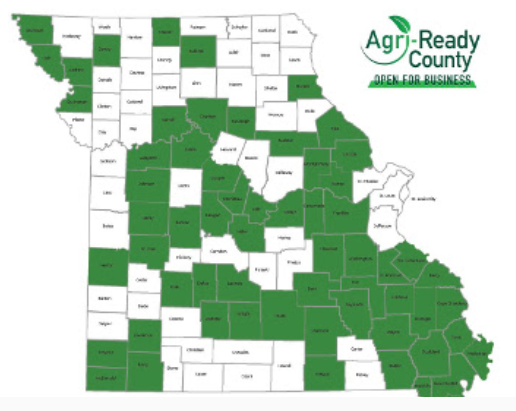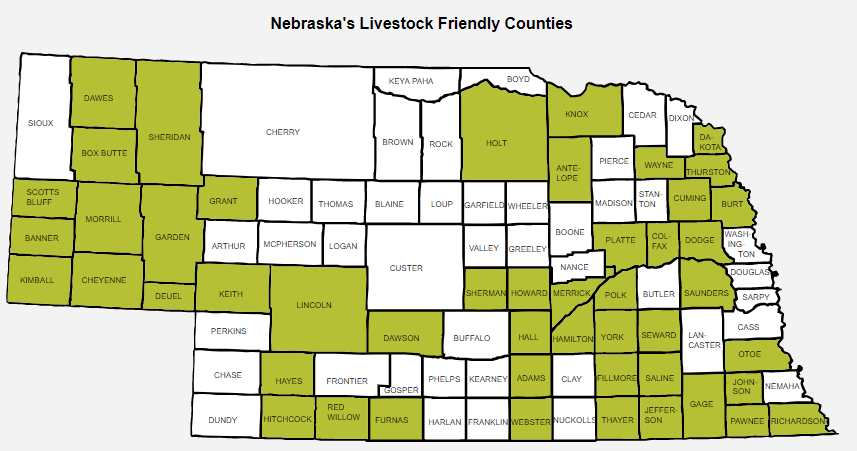posted on Tuesday, November 26, 2019
I recently read an article in Morning AgClips regarding a county in Missouri attaining the designation of “Agri-Ready”. Morning AgClips is a news service that I use to stay informed about agricultural activity in nine states. I also have a long-time connection to Nebraska being born in Wayne County and raised on a farm in Platte County. I know they have a program administered by the Nebraska Department of Agriculture called “Livestock Friendly County”.
I have the great opportunity of working with a team of professionals at Decision Innovation Solutions (DIS) on projects related to all phases of the agriculture value chain from production to value-added processing. Many of the projects involve animal agriculture including animal care and nutrition. So, I thought I would just check around and see how the farmers and ranchers who produce our food are valued in many of the states in the Midwest.
First, a brief disclaimer. This is not an exhaustive research project and it relies on information I have gained from personal research and input from some friends and contacts in the industry.
The states I included in my research are the twelve states typically viewed as the Midwest. They are Illinois, Indiana, Iowa, Kansas, Michigan, Minnesota, Missouri, Nebraska, North Dakota, Ohio, South Dakota and Wisconsin. I’m going to start with Missouri because that state was featured in the article in Morning AgClips and the economic facts used in the article came from a 2016 Agriculture & Forestry Economic Contribution Study (AECS) completed by our team at DIS.
“Missouri Farmers Care (MFC), a coalition of more than 40 leading Missouri agricultural groups, designates counties that create an environment conducive to agricultural entrepreneurship and opportunity which actively support Missouri’s largest industry.”
“Through the Agri-Ready program, MFC partners with county leaders to advance local agricultural enterprise, promote the county as a prime location for business expansion and enhance workforce readiness for agricultural careers. In addition, MFC recruits local 4-H and FFA leaders to implement Agriculture Education on the Move™ in third-grade classrooms. These student leaders will present agricultural careers, crop science, and livestock production segments through engaging, hands-on activities and lessons while developing their speaking and leadership skills.”

Morning Ag Clips-September 17, 2019
As I mentioned, I might be a little partial to Nebraska and they also have a program named “Livestock Friendly County (LFC) in place so they are next on my list.
The LFC program is voluntary. LFC was created by the Nebraska Legislature in 2003 and is administered by the Nebraska Department of Agriculture (NDA). NDA uses the program to assist counties and agricultural producers in promoting the livestock industry. As of December 4, 2018, there were 49 counties with the LFC designation.

https://nda.nebraska.gov/promotion/livestock_friendly/index.html
The state of Kansas doesn’t have a program in place to designate livestock friendly zones. According to Ryan Flickner, Senior Director of Public Policy at Kansas Farm Bureau, “We do not have anything in Kansas by county. Some of this stems from Kansas being one of the first in the nation to have a statewide livestock permitting standard that takes precedence over county standards (i.e., counties CANNOT have a more restrictive regulation than the state).” This statewide permitting standard helps livestock producers by preventing local governments from creating rules and regulations designed to make it impossible for the producer to comply.
Wisconsin has a similar approach. The livestock siting law was passed in 2003 as Wisconsin Act 235. The law directed the Wisconsin Department of Agriculture, Trade and Consumer Protection (DATCP) to create rules regarding the siting of livestock facilities in the state. Those rules became known as ATCP 51 and took effect in 2006. They set standards for siting new facilities in areas of the state zoned for agricultural uses, and on livestock operations expected to house more than 500 animal units. Wisconsin’s livestock siting law provides consistent, statewide standards and procedures for local governments to regulate the construction of new or expanding livestock facilities over a certain size. It also established the Livestock Facility Siting Review Board as a method of appeal for applicants, and it set a timeline for review and approval of new facilities.
Michigan has a Right to Farm Law (RTF). According to Matt Smego, Associate Director, Public Policy & Commodity Division for the Michigan Farm Bureau, “Michigan does not have a specific designation for agriculturally friendly counties. This is probably in part because Michigan’s Right to Farm Law preempts local units of government from adopting ordinances more restrictive from the RTF including siting for new and expanding livestock operations. We have encouraged members to adopt Generally Accepted Agricultural and Management Practices and verification in the Michigan Agriculture Environmental Assurance Program to assist with good neighbor relations.” As in Kansas and Wisconsin, Michigan’s RTF provides its agricultural producers a fair and consistent playing field when they are considering new or expanded operations.
Iowa does not have any statewide or county level livestock friendly designations. The Coalition to Support Iowa’s Farmers (CSIF) was created by farmers in 2004 with the mission of working with farmers to advocate and help implement on-farm best-management practices that assist Iowa’s farm families in raising livestock responsibly and successfully.
The Coalition is a joint partnership involving the Iowa Beef Industry Council, Iowa Cattlemen’s Association, Iowa Corn Growers Association, Iowa Farm Bureau Federation, Iowa Pork Producers Association, Iowa Poultry Association, Iowa Soybean Association, Iowa Turkey Federation and Midwest Dairy Association. CSIF is a non-profit, non-partisan organization that provides assistance to farmers at no cost. It does not lobby or develop policy.
Illinois has a Livestock Facility Management Act (LFMA) that is administered by the Illinois Department of Agriculture. The original act was passed in 1996. It provides a process for livestock producers to follow when they are planning expansion of existing operations or siting of new operations. They start the process by submitting a Notice of Intent to Construct (NOITC). This initiates a process that both the producer and the local government entity must follow.
South Dakota has several programs in place that support the expansion of livestock production in the state. One of the programs is designed specifically to provide financial support for young farmers who want to own and manage a livestock production operation. However, I was not able to find any support for addressing siting issues at the local level.
Based on my research, the rest of the states; Minnesota, Indiana, Ohio, and North Dakota do not have programs in place that support agriculture producers who are planning expansions or new locations for livestock and/or poultry production facilities.
It is interesting to note that 4 of the states mentioned; Iowa, Missouri, South Dakota and Illinois have Agriculture Economic Contribution Studies in place that were produced by DIS. Kansas has an AECS produced by their department of agriculture. Wisconsin and Nebraska have AECS studies similar to the ones produced by DIS that were produced by their land grant universities. It seems to me that the states who have programs in place to support production agriculture also know the value of agriculture’s contribution to their state’s economy.